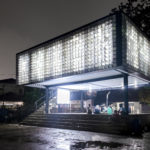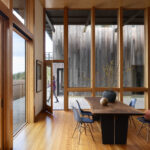Cuban-born and architecturally trained, 101-year-old Carmen Herrera has been a practicing artist since she moved to New York in 1939. Why, then, has she only begun to receive due recognition in the last decade?

According to Dana Miller, former Richard DeMartini Family Curator and Director of the Collection at the Whitney Museum of American Art, Herrera’s identity as a woman and an immigrant explains why she was shut out of the American abstract art canon for years. Miller hopes to change that with “Carmen Herrera: Lines of Sight,” opening today. The exhibition presents the first close examination of the artist’s early career, with work spanning 1948 to 1978. In 50 pieces on canvas, paper and freestanding acrylic-on-wood, Herrera displays her signature hard-edge style and unites her architecture background with her abstract practice. Although Herrera never worked in architecture after leaving Havana, Cuba, for New York, a spacial awareness permeates her art.
“Architecture school was where she learned to render three-dimensional form and translate it onto two-dimensional canvases,” says Miller, who in organizing this exhibition spent countless hours with Herrera in the artist’s studio. “In all of these paintings here, she was thinking about them in an architectonic way.”

With the exhibition’s last room devoted to Herrera’s three-dimensional work, like the bright yellow Amarillo “Dos”,1971, Miller hopes the abundance of isometric forms will prompt visitors to reconsider the show’s other two-dimensional works and see their engagement with spacial planes.
The Whitney began its vigorous reexamination of Herrera’s oeuvre in the 2014 lead-up to the opening of the new Renzo Piano–designed Whitney building, purchasing the bold, beautiful Blanco y Verde, 1959. Just as she was an outsider to the Whitney circle of abstract artists, which included the likes of Frank Stella and Ellsworth Kelly, so, too, was she to architectural practice. The fact that her recent ascent into the canon of art history involved both the art and architecture elite, then, is a triumph, an ultimate testament to her validity in both spheres.

Whitney Director Adam Weinberg capped off his opening remarks at the exhibition’s preview with an emphatic declaration: “This is an important show for the Whitney. It’s an important show for New York. It’s an important show for the United States.”
And it’s just as important for the integration of art and architecture.
“Carmen Herrera: Lines of Sight” is on view at the Whitney Museum of American Art from Sept. 16, 2016, to Jan. 2, 2017. Visit the exhibition webpage.
All photos by Lucy Wang; top image via BlouinArtinfo









